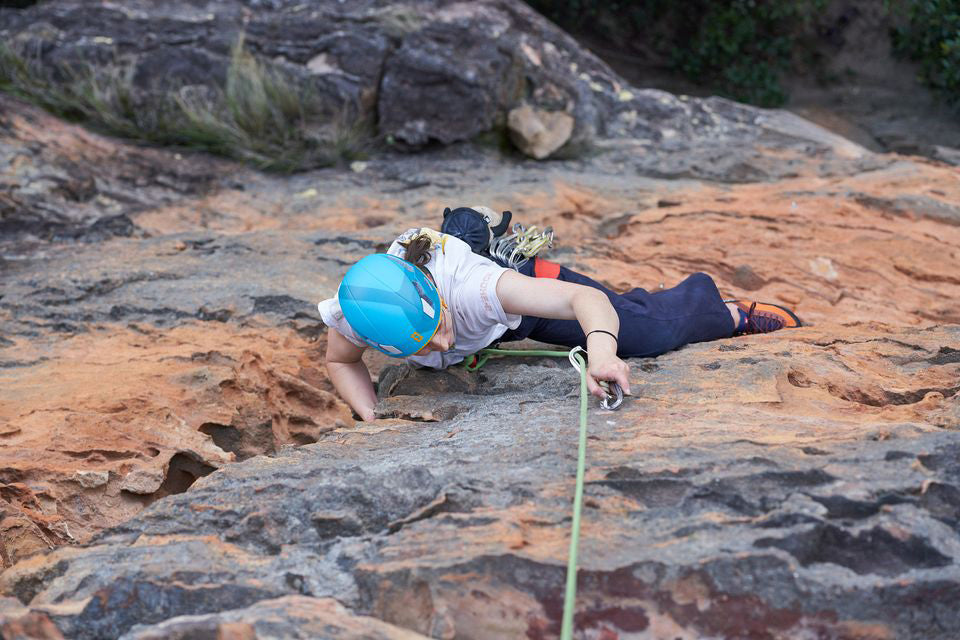Rock climbing is a unique activity that brings energy and adrenaline to its enthusiasts. It can be very challenging, and that’s why safety and security are so important when climbing.
That can be guaranteed by having the appropriate gear. We have prepared for you a list of the basic rock climbing and abseiling equipment you need as a climber.
Enjoy.
Table of contents
- Rock Climbing Ropes
- Rock Climbing Harnesses
- Carabiners
- Quickdraws
- Belay device
- Climbing Helmet
- Rock Climbing Shoes
- Chalk and Chalk Bags
- Crash Pads
Rock Climbing Equipment List
You can find a summary of our rock climbing gear list in the infographic below.
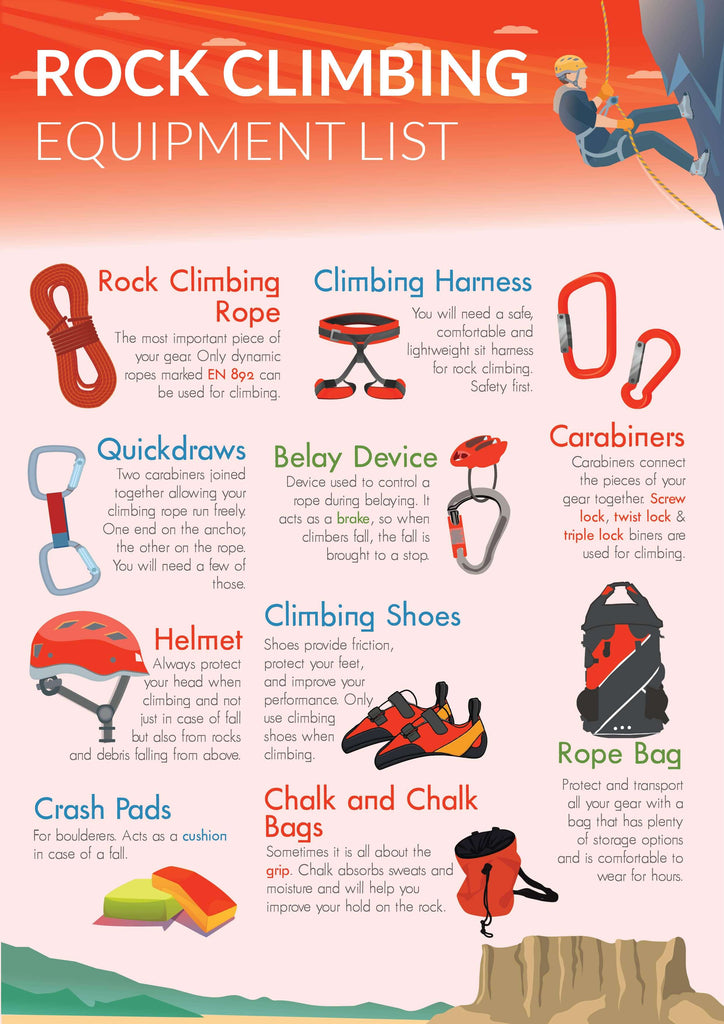
Rock Climbing Ropes
Well, it is no surprise that we start our rock climbing equipment list with climbing ropes. A climbing rope is probably the most important piece of rock climbing equipment that you need.
Classification of climbing ropes
In general, there are two types of ropes: static ropes and dynamic ropes.
Static ropes are stiff and have low elasticity. They are mainly used for rappelling and rescues, but not for rock climbing. On the other hand, dynamic ropes are suitable for rock climbing. They are designed with some elasticity that helps them to absorb fall impact energy.
One of the biggest differences from dynamic and static ropes is the elongation, as the elasticity is much bigger on dynamic ropes. Standard fall tests require a maximum of 12 kN (around 1200kg) impact force for dynamic ropes.
Remember, only ropes marked EN 892 can be used for climbing!
Dynamic climbing ropes in more detail
Let’s look at dynamic rock climbing ropes in more detail. According to their purpose of use, there are three types of dynamic ropes: single ropes, half ropes and twin ropes.

Single rope
Single ropes are used in the belay chain in a single line. They are ideal for sport routes or climbing gyms.

Half rope
This type of dynamic rope is used in pair: in two independent belay lines (left and right). It is suitable for mountaineering, ice climbing or multi-pitch climbing.
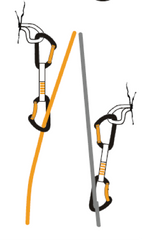
Twin rope
Twin ropes are also used in pair but parallel to one line. Usually, twin ropes are used when a risk of rock or ice fall occurs, for example during big wall climbing, mountaineering or multi-pitch climbing.

Take care of your rock climbing rope properly
A climbing rope will last the longest in a dry and dark place. You should never store the rope near chemicals. If the rope gets wet, it is necessary to always let it dry. However, do not expose the rope to direct sunlight or heat sources.
Sunlight is also harmful, therefore never leave the climbing rope in the sun longer than necessary. Its biggest enemy is dust elements or dirt.
By using a rope bag or rope sheet you avoid unnecessary wear and tear of the rope as well as of carabiners, which are also worn out quickly by dust particles.

Rock Climbing Harnesses
Let’s move on to another very important piece of rock climbing equipment – a sit harness that allows you to securely tie yourself to the climbing rope.
When it comes to selecting the right climbing harness, safety and quality should always come first. You should also consider whether the harness is comfortable and lightweight.
As you can see in the following picture, every sit harness consists of a waistbelt and leg loops:
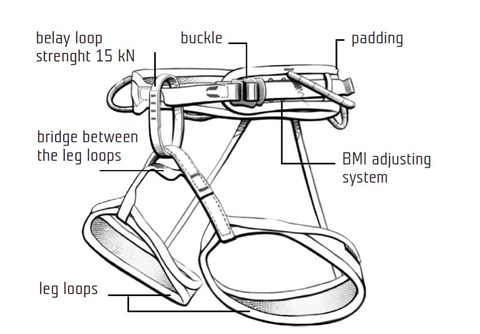
Basic types of rock climbing harnesses
The type of rock climbing harness that is best for you depends on what kind of climbing you are about to do.
Based on the type of rock climbing, we can divide climbing harnesses into following categories:
-
Sport Harness
These harnesses have 1 buckle, are simple, light and they help you achieve maximum climbing performance. -
Universal Harness
Universal harnesses have 3 or 4 buckles, and it allows variable adjustment according to the use. -
Bigwall Harness
A very comfortable harness, with a lot of gear loops and 3 or 4 buckles. -
Skitouring Harness
Skitouring harnesses with 1–3 buckles are light and could be put on even whilst wearing the skis or crampons. -
Canyoning Harness
These harnesses intended for canyoning have 3 buckles and a special sit protector.

How to put on climbing harness correctly?
You can look how to put on climbing harness correctly on this video from Singing Rock.
How to take care of rock climbing harness?
Similarly to the climbing rope, you should protect your rock climbing harness against long-lasting direct sunlight, direct heat sources, acids, lixiviants, dyes and bleaches that damage synthetic fibres.
If your climbing harness is dirty, wash it by hand with cold water and soap solution.
Dry in the dark at a temperature approximately 22°C. Check your rock climbing harness regularly to make sure the seams are unbroken, that the steel parts and buckles are not damaged and are still fully functional.
Most rock climbing harnesses are integrated with a wear indicator at tie-in-points, a colourful stitching that is only visible once the harness has been overly worn.

Rock Climbing Carabiners
As a climber, you will need carabiners as part of your climbing equipment. Let’s take a closer look at climbing carabiners, its components and classifications.
Components of climbing carabiners
To help you with terminology related to carabines, this is how main components of carabiners are called:
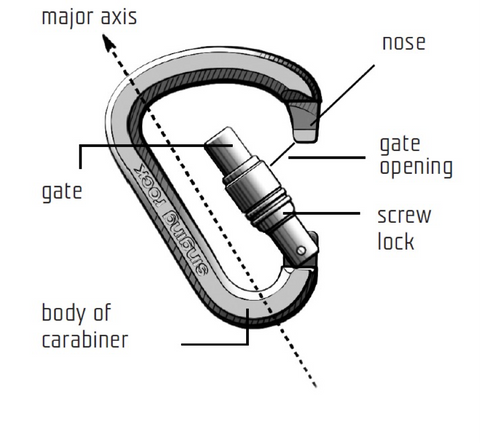
Obviously, the basic and the biggest part of climbing carabiner is its body. A carabiner is closed by a gate that ensures that climbing rope does not slip out.
The safety lock secures carabiner from its unintentional opening after closing. There are various types of locking mechanisms including screw, twist and triple lock.
Classification of climbing carabiners
According to the norm EN12275:98 we can classify carabiners by their construction and strength requirements in different ways of use.
In real climbing conditions we choose a carabiner according to the purpose of use, material and type of locking mechanism. At first, based on the locking mechanism, we distinguish three different types of climbing carabiners:
Screw lock carabiners
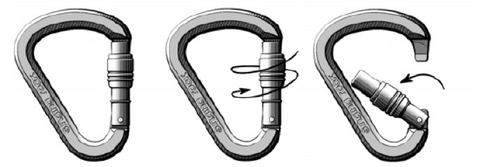
Screw lock is a classic manual system that can be operated with one hand. It is reliable in dirty or harsh environments, but its disadvantage is the time it takes to lock the sleeve.
Twist lock carabiners

Twist lock carabiners are much faster opening than screw lock carabiners thanks to the auto-locking system. However, two hands are needed when inserting a device into the carabiner.
Triple Lock carabiners

Fast opening thanks to the auto-locking. Similar to the twist lock, two hands are needed when inserting a device into the carabiner. The sleeve operation can be tricky and requires practice.
Now, let’s move to the classification of climbing carabiners according to the purpose of use.
-
TYPE B (BASIC)
Type B is a basic universal carabiner that has various shapes and sizes. It is primarily used in the belay system.
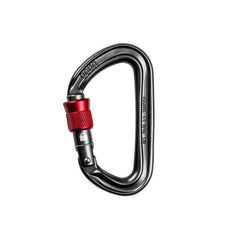
-
Type H (HMS)
The pear-shaped carabiner primarily used for dynamic belaying with a Munter hitch. For added security it is fitted with a screw or automatic locking mechanism. HMS stands for German word “Halbmastwurfsicherung”, meaning a half clove hitch belay.
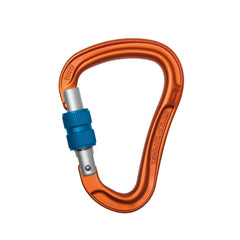
-
Type K (Klettersteig) - for secured routes
This climbing carabiner has an automatic locking mechanism, and it is primarily used for self-belay on secured routes, such as via ferrata.
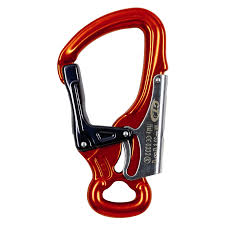
-
Type D (Directional) - with locked position of the rope
The shape of the carabiner prevents the dangerous side loading of the carabiner. This type of climbing carabiner is designed exclusively for connection to an EN566 loop express.
-
Type X – Oval
Oval carabiners are designed for the connection with climbing ascenders, descenders, or pulleys. They are also suitable for rescue techniques. However, oval carabiners are not designed for belaying with a Munter hitch.
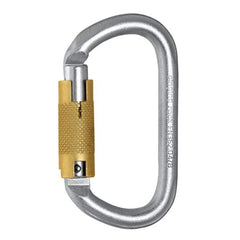
-
Type Q (Quick link) – climbing carabiner with screw lock
The last type of climbing carabiner is type Q. It has a screw lock closed by screwing the nut, which is the bearing part of the carabiner. Type Q carabiners are designed especially for permanent connections, for example connecting a chain at a belay station, or quickdraw for the climbing gyms.
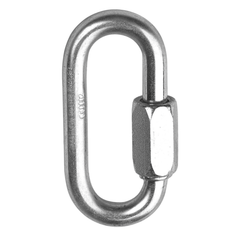
Quickdraws
Speaking of carabiners, we should also mention another piece of rock climbing equipment you will likely need (and a few of): a quickdraw.

Quickdraws are two carabiners joined together with a textile webbing, providing an extension to gear placements, allowing the climbing rope to run freely. One carabiner – the one with a straight gate – is connected to the anchoring device and the other – the one with a bent gate – is used for a climbing rope.
Belay and rappel device
Another important piece of rock climbing hardware is a belay device that is used to control a rope during belaying.

The belay device increases friction and that helps the belayer - the person on the ground whose responsibility it is to secure the climber - to handle his duties with minimal physical effort. It acts as a brake, so when climbers fall, the fall is brought to a stop.
There are multiple belay devices on the market, tubular, assisted braking or figure 8. Each has their own function depending on the type of rock climbing that you are doing.
Tubular belays work for multi-pitch trad climbing, sport climbing and gym climbing. They’re lightweight, easy to use and can also be used for rappelling.
Assisted Braking Belay Devices are also good for sport climbing, gym climbing and multipitch trad climbing. They’re designed to auto-lock when a sudden force is applied to the rope, helping the belayer catch the weight of a fall.
The Figure 8 belay device is designed for search and rescue, caving and rappelling. They’re efficient, dissipate heat from friction efficiently and can be used with just about any rope diameter. They require more attention and force from the belayers hands and aren’t ideal for beginners.
How to take care of hardware and metal rock climbing equipment?
You should always take proper care of your rock climbing hardware, such as carabiners, quickdraws or belay devices, because metal parts of this rock climbing equipment are subject to corrosion.
Therefore, you should allow them to dry thoroughly after the use. Keep in mind that fabric parts can be damaged by moisture, in which mold or rust can appear.

Other Essentials
The rock climbing rope, harness and hardware, such as carabiners and quickdraws, are the basic types of rock climbing equipment. However, there are other essentials you will need as a rock climber.
Climbing helmet
A helmet is one of them.
You should always protect your head when rock climbing and not just in case of fall but also from rocks and debris falling from above.

You should pay special attention to choosing the right helmet, as with choosing the right rock climbing harness, safety should come first. Make sure that the helmet is designed for rock climbing.
Secondly, the helmet should be comfortable, fit well on your head and not be too loose or too tight.
Rock climbing shoes
When gearing up for rock climbing, you also need rock climbing shoes. It will help you improve your performance, provide friction and protect your feet.
Shoes should be comfortable, easy to put on and take off. Take a good care of your rock climbing shoes and use them only when climbing.
Chalk and chalk bags
Grip is an important factor when climbing. If you want to improve your hold on the rock, you should consider using chalk when climbing.

Chalk absorbs sweat and moisture from your hands. As apart of your climbing equipment you will need a chalk bag attached to the harness to store your chalk.
Crash pads
If you plan to go bouldering, you will need a crash pad that acts like a cushion in case of a fall or dismount. Crash pads help climbers prevent injuries when falling from short heights.
These pads are made in various styles and sizes. They often contain two or three different kinds of foam. Many crash pads came with shoulder straps so they can be worn while hiking or with pockets for storing climbing equipment.
Conclusion
Hopefully, now you have a better idea what rock climbing equipment you need as a climber.
One last tip: always check your gear before climbing and make sure it is not damaged and does not need to be replaced. Safety first. Always.

